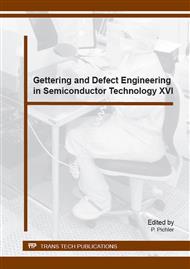[1]
C. Möller, A. Laades, and K. Lauer, Solid State Phenomena 205-206, 265 (2013).
DOI: 10.4028/www.scientific.net/ssp.205-206.265
Google Scholar
[2]
L.C. Kimerling and J.L. Benton, Physica B 116, 297 (1983).
Google Scholar
[3]
C. Möller, T. Bartel, F. Gibaja, and K. Lauer, J. Appl. Phys. 116, 024503 (2014).
Google Scholar
[4]
C. Sun, F.E. Rougieux, and D. Macdonald, J. Appl. Phys. 117, 045702 (2015).
Google Scholar
[5]
J. D. Murphy and R. J. Falster, Phys. Status Solidi RRL 5, 370 (2011).
Google Scholar
[6]
K. Lauer, C. Möller, D. Schulze, T. Bartel, and F. Kirscht, Phys. Stat. Sol. (RRL) 7, 265 (2013).
Google Scholar
[7]
K. Lauer, C. Möller, T. Bartel, and F. Kirscht, Energy Procedia 55, 545 (2014).
Google Scholar
[8]
A. Laades, M. Blech, M. Bahr, K. Lauer, and A. Lawerenz, Phys. Stat. Sol. C 8, 763 (2011).
Google Scholar
[9]
R. A. Sinton and A. Cuevas, Appl. Phys. Lett. 69, 2510 (1996).
Google Scholar
[10]
K. Lauer, A. Laades, H. Übensee, H. Metzner, and A. Lawerenz, J. Appl. Phys. 104, 104503 (2008).
DOI: 10.1063/1.3695381
Google Scholar
[11]
K. Lauer, M. Herms, A. Grochocki, and J. Bollmann, Solid State Phenom. 178-179, 211 (2011).
DOI: 10.4028/www.scientific.net/ssp.178-179.211
Google Scholar
[12]
R. Brendel, Appl. Phys. A 60, 523 (1995).
Google Scholar
[13]
G. Zoth and W. Bergholz, J. Appl. Phys. 67, 6764 (1990).
Google Scholar
[14]
D. Macdonald, L. J. Geerligs, and A. Azzizi, J. Appl. Phys. 95, 1021 (2004).
Google Scholar
[15]
A.A. Istratov, H. Hieslmair, and E.R. Weber, Appl. Phys. A 69, 13 (1999).
Google Scholar
[16]
D. V. Lang and L.C. Kimerling, Phys. Rev. Lett. 33, 489 (1974).
Google Scholar
[17]
H. Lemke, Phys. Stat. Sol. (a) 64, 215 (1981).
Google Scholar
[18]
K. Wünstel and P. Wagner, Appl. Phys. A 27, 207 (1982).
Google Scholar
[19]
H. Lemke, Phys. Stat. Sol. (a) 76, 223 (1983).
Google Scholar
[20]
J.H. Reiss, R.R. King, and K.W. Mitchell, Appl. Phys. Lett. 68, 3302 (1996).
Google Scholar
[21]
E.R. Weber, Appl. Phys. A 30, 1 (1983).
Google Scholar
[22]
L. C. Kimerling, MRS Online Proceedings Library 2, 85 (1980).
Google Scholar
[23]
D. Macdonald, T. Roth, P.N.K. Deenapanray, K. Bothe, P. Pohl, and J. Schmidt, J. Appl. Phys. 98, (2005).
Google Scholar
[24]
S. Beljakova, PhD thesis, (2005).
Google Scholar
[25]
T. Bartel, F. Gibaja, O. Graf, D. Gross, M. Kaes, M. Heuer, F. Kirscht, C. Möller, and K. Lauer, Appl. Phys. Lett. 103, 202109 (2013).
DOI: 10.1063/1.4830227
Google Scholar
[26]
L.J. Geerligs and D. Macdonald, Appl. Phys. Lett. 85, 5227 (2004).
Google Scholar


